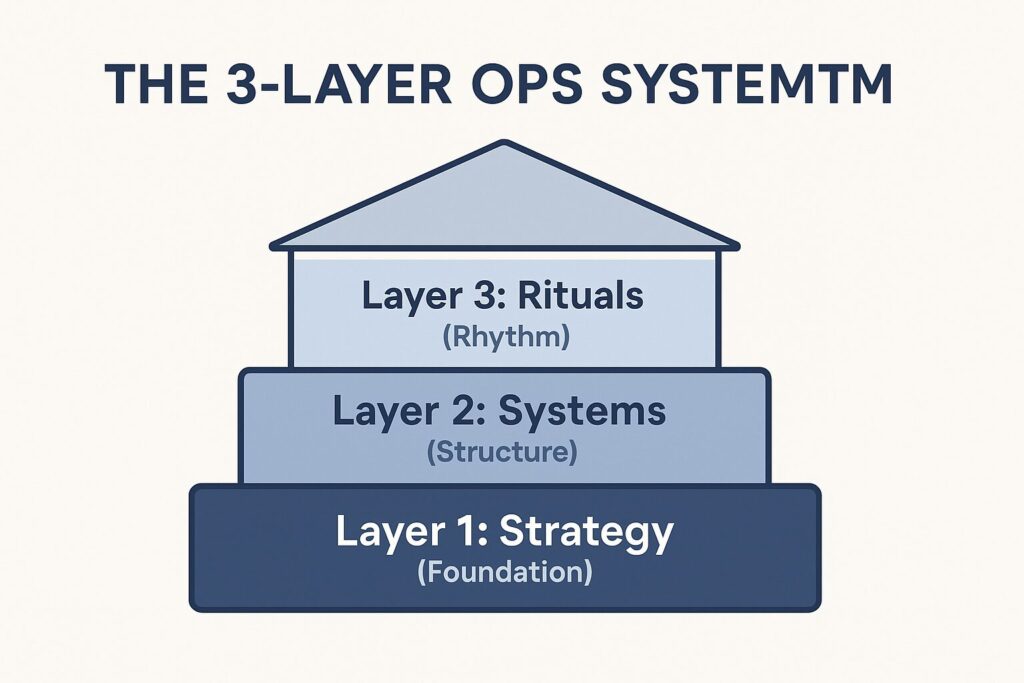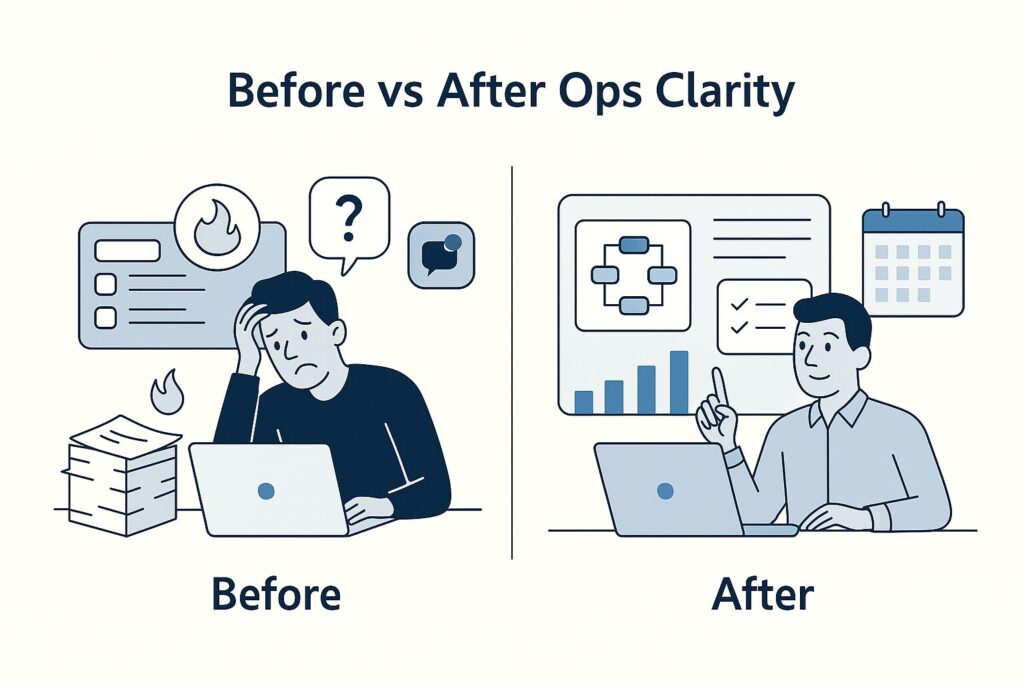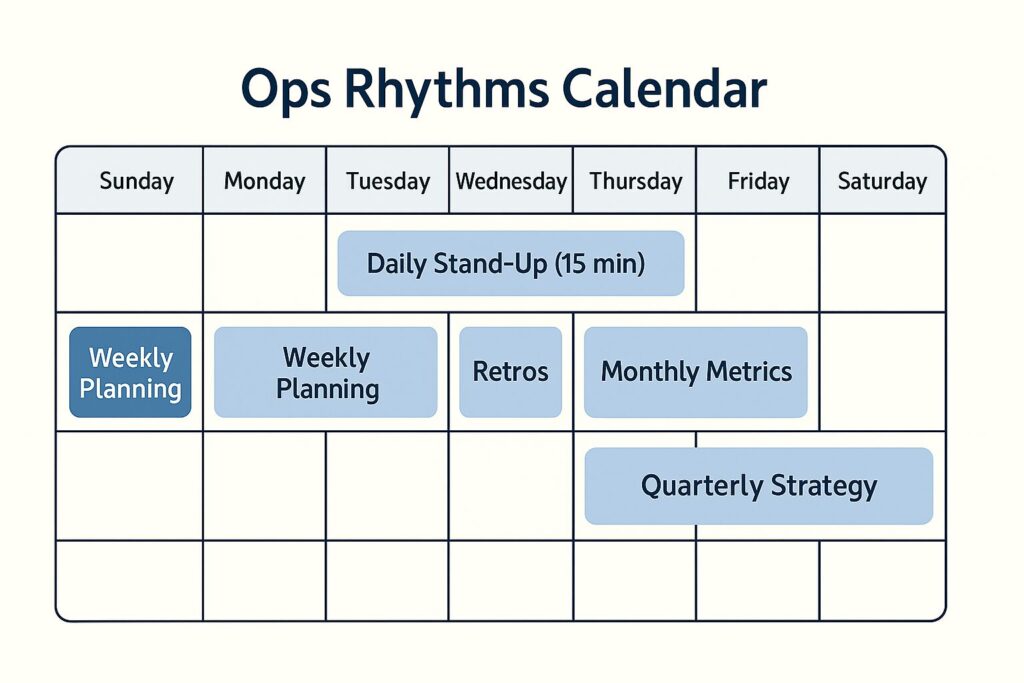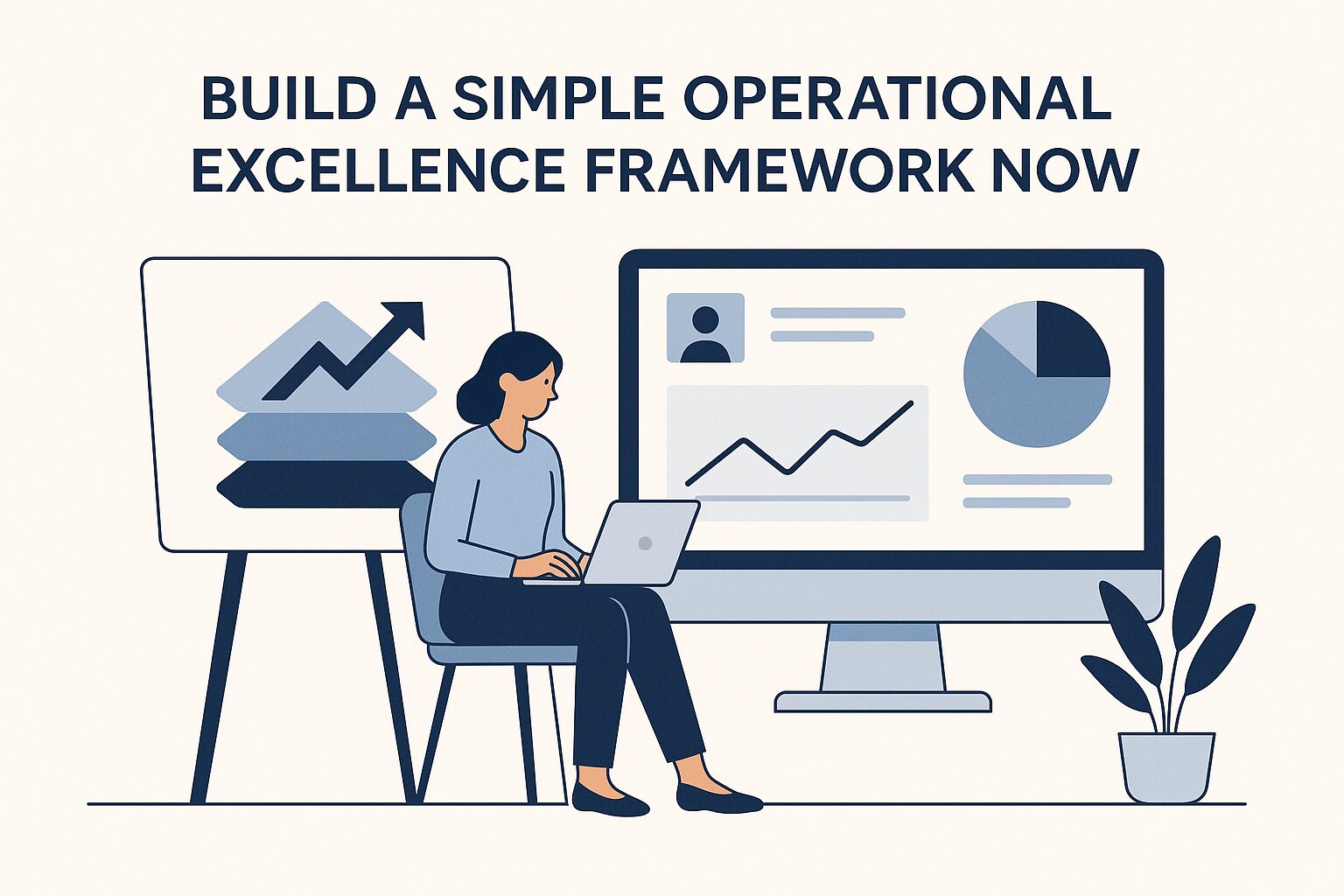Picture this: You’re six months into your dream COO role, and instead of feeling like the strategic mastermind you imagined, you’re drowning in a sea of urgent Slack messages, missed deadlines, and processes that seem to change daily. If this sounds all too familiar, you’re not alone.
If you’re a COO, Director of Ops, or startup founder scaling fast, this blueprint is for you.
Here’s the thing: most operational leaders get it wrong by trying to fix everything at once. They dive headfirst into optimizing individual processes without taking a step back to see the bigger picture. It’s like trying to organize a messy garage by rearranging the tools while the foundation is crumbling beneath your feet.
After spending the last decade building and rebuilding operations across startups and scale-ups, I’ve discovered that a truly exceptional operational excellence framework isn’t about having perfect processes. It’s about the power of strategic clarity, a three-layer system that transforms chaos into clarity, one strategic decision at a time.

What Most New Operations Leaders Get Dead Wrong
Let me tell you about Jim (not his real name), a brilliant product manager who got promoted to VP of Operations at a fast-growing SaaS company. His first month? He created 47 new process documents, implemented three new project management tools, and scheduled 23 recurring meetings to “improve alignment.”
The result? More chaos, not less.
Jim made the classic rookie mistake that nearly every new ops leader makes: He confused motion with progress. He was so focused on implementing business operations strategy tactics that he never built the foundation for sustainable change.
The real problem wasn’t his team’s inability to follow processes. It was that he hadn’t created the strategic clarity, systematic thinking, and cultural rituals needed to make those processes stick.
This isn’t just anecdotal experience. Research backs up the importance of systematic approaches to operational transformation. According to a study by McKinsey, companies that focus on continuous process improvement see a 25% increase in productivity compared to those that don’t. More telling, a capability-building program at a large Asian energy company triggered cumulative operational savings of approximately US$500 million within the first two years by focusing on precisely what Jim had missed: a strategic foundation, systematic capability building, and cultural transformation.
Here’s the mindset shift that changes everything: Operations isn’t about controlling chaos; it’s about creating the conditions where clarity naturally emerges.
The 3-Layer Ops System (TM): The S.S.R. Framework (Strategy, Systems, Rituals)
A proven framework for scaling clarity, consistency, and execution.
From early-stage startups to mature operating teams, I’ve worked across a range of environments to distill the most effective operational playbook into three layers.
Layer 1: Strategy (The Foundation)
Layer 2: Systems (The Structure)
Layer 3: Rituals (The Rhythm)
Think of it like building a house. Strategy is your foundation — without it, everything else crumbles. Systems are your frame and walls — they provide structure and define how things flow. Rituals are your electrical and plumbing — they keep everything running smoothly day after day.
Most COO playbook approaches focus only on Layer 2 (systems and processes), which is why they fail. You can’t build sustainable operations without all three layers working in harmony.
A holistic approach matters more than most leaders realize. McKinsey research on operational excellence reveals that companies implementing systematic capability building across technical systems, management infrastructure, attitudes, and leadership achieve significantly better results than those focusing solely on processes. Their analysis of transformation programs revealed that holistic approaches yielded cumulative savings of over $680 million, compared to traditional process-only initiatives.

Layer 1: Strategy – Building Your Operational North Star
Before you touch a single process or implement any new tool, start with strategic clarity. Don’t create a 20-slide deck that ends up forgotten in someone’s Google Drive. You’re defining the three fundamental questions that will guide every operational decision going forward:
The Three Strategy Anchors
1. What Does Success Look Like at Scale?
Most ops leaders think tactically: “How do we handle twice as many customers?” But strategic thinking asks: “What capabilities do we need to build today so that scaling feels effortless tomorrow?”
I learned this lesson the hard way at a previous startup. We were growing at a 15% month-over-month rate, and I continued to hire additional customer success representatives to handle the increased volume. But I never asked the strategic question: “How do we create systems that make our customers more successful without proportionally increasing our team size?”
The result? We scaled our headcount faster than our revenue, and our unit economics went sideways. A strategic approach would have focused on building self-service capabilities, improving onboarding automation, and creating feedback loops that prevented issues before they reached our team.
2. Where Are Our Biggest Operational Bottlenecks?
Here’s where most operations audit approaches go wrong — they focus on obvious inefficiencies instead of strategic constraints. A bottleneck isn’t just a slow process; it’s the constraint that limits your entire system’s capacity to grow.
Use what I call the “Traffic Light Analysis”:
- Red zones: Critical bottlenecks that stop growth entirely
- Yellow zones: Inefficiencies that slow you down but don’t stop you
- Green zones: Areas that are working well and should be protected
Focus 80% of your energy on red zones, 15% on yellow zones, and 5% on protecting your green zones from well-meaning “improvements.”
3. What’s Our Operational Philosophy?
It may sound theoretical, yet it’s the cornerstone of scalable ops. Your operational philosophy is the lens through which you make thousands of decisions every day. It answers questions like:
- Do we optimize for speed or quality when they conflict?
- How much autonomy do we give teams versus standardized processes?
- When should we build, buy, or partner?
At one company, our operational philosophy was “Simple scales, complex fails.” This single principle helped us make consistent decisions about tool selection, process design, and team structure. When someone proposed a solution, we’d ask: “Does this make things simpler or more complex?” If the answer were more complex, we’d find another way. Another example of an operational philosophy is ‘Customer first’, which guides decisions aimed at improving customer experience and satisfaction.
Layer 2: Systems – Building Your Operational Backbone
Once you have strategic clarity, you can build systems that support your goals. But here’s the key insight most people miss: process optimization should be about creating predictable outcomes, not perfect processes.
The Four Pillars of Scalable Systems
1. Information Architecture
Think of information architecture as the nervous system of your operations. Just like your brain needs to know what’s happening in your body to make good decisions, your team needs access to the correct information at the right time.
Most companies have an information accessibility problem disguised as a process problem. People aren’t following your customer onboarding process because they can’t easily find the latest version, understand when to use it, or see what happened in previous steps.
Create what I call “Single Source of Truth” for each central operational area:
- Customer data and interaction history
- Product roadmap and feature specifications
- Financial metrics and forecasting
- Team capacity and project status
The rule is simple: Every piece of operational information should live in exactly one place, be updated by exactly one person or system, and be accessible to everyone who needs it.
2. Decision-Making Frameworks
Most operational chaos stems from unclear decision rights. Who decides when to escalate a customer issue? What criteria do we use to prioritize feature requests? How do we resolve conflicts between departments?
I use a framework called RAPID (Recommend, Agree, Perform, Input, Decide) for any decision that will be made more than once. Here’s how it works:
- Recommend: Who gathers information and makes a recommendation?
- Agree: Who must agree before the decision can move forward?
- Perform: Who executes the decision?
- Input: Which stakeholders should we actively involve in the decision-making process?
- Decide: Who makes the final call?
For example, when we implemented this for customer refund decisions:
- Recommend: Customer Success Manager reviews the case
- Agree: Finance confirms refund amount and method
- Perform: Billing team processes the refund
- Input: The Product team provides context on the issue
- Decide: CS Manager makes final decision for refunds under $500; VP Customer Success for larger amounts
It eliminated 80% of the ‘Who owns this?’ confusion that was slowing us down.
3. Quality Control Systems
Quality control isn’t about catching mistakes after they happen. It’s about designing systems that prevent mistakes from happening in the first place. At this stage, systems thinking helps eliminate friction and build process consistency.
The best quality control systems have three characteristics:
- Prevention: They make it hard to do the wrong thing
- Detection: They quickly identify when something goes wrong
- Correction: They have clear escalation paths for fixing issues
One company I worked with was struggling with data quality in their CRM. Instead of training people harder on data entry, we implemented prevention systems: We implemented required fields for key data points, used dropdown menus instead of free text wherever possible, and set up automatic validation rules to flag errors before saving.
4. Feedback Loops
Over time, gaps, inefficiencies, and misalignment tend to emerge in this area. You implement a great process, it works for a while, then conditions change, and the process becomes less effective. Without feedback loops, you don’t realize there’s a problem until it’s causing significant pain.
Build feedback loops at three levels:
- Real-time: Dashboards and alerts that show current performance
- Weekly: Regular reviews of key metrics and leading indicators
- Quarterly: Strategic assessment of whether your systems are supporting your goals
Layer 3: Rituals – Creating Your Operational Rhythm
Systems tell you what to do. Rituals ensure it gets done. Here’s where leadership rituals quietly power the consistency and clarity behind world-class operations.
The Power of Predictable Rhythms
Think about the best sports teams you’ve ever watched. What separates great teams from good ones isn’t just talent or strategy. It’s the rhythm of preparation, execution, and improvement that becomes second nature.
The same principle applies to operations. Great operational teams have predictable rhythms that create momentum, alignment, and continuous improvement.

Daily Rhythms: The Heartbeat
Every high-performing operations team needs three daily touchpoints:
- Morning Alignment (15 minutes): What’s the focus today? Any blockers?
- Progress Check (5 minutes): Are we on track? What do we need to adjust?
- Daily Wrap (10 minutes): What did we learn? What needs attention tomorrow?
These aren’t status meetings — they’re alignment rituals that keep everyone moving in the same direction.
Weekly Rhythms: The Pulse Check
Weekly rituals should focus on cross-functional alignment and strategic course corrections:
- Monday: Week ahead planning and priority setting
- Wednesday: Mid-week progress review and obstacle clearing
- Friday: Weekly retrospective and continuous improvement
The key is consistency. These meetings take place every week, at the same time and in the same format, whether the business is booming or struggling.
Monthly & Quarterly Rhythms: The Strategic Reset
Monthly and quarterly rituals are where you zoom out and ensure your day-to-day operations are supporting your strategic goals:
- Monthly: Deep dive on key metrics, team performance, and process effectiveness
- Quarterly: Strategic review of systems, team capabilities, and market alignment
Building Ritual Discipline
Here’s what I’ve learned about making rituals stick: start small, be consistent, and focus on value over perfection.
When I first implemented operational rituals at a fast-growing startup, I made the mistake of trying to establish too many new rhythms at once. The team felt like we were always in meetings and never getting work done.
The breakthrough came when I introduced a single ritual: a 15-minute daily stand-up focused solely on clearing blockers. No status updates, no lengthy discussions — just “What’s blocking you from making progress today, and how can we help?”
Within two weeks, the team was moving faster than ever. They experienced the value firsthand, which made them open to adding other rhythms over time.
Real-World Example: The Turnaround That Changed Everything
Let me share how this framework played out in practice. As MyEListing accelerated, I led efforts to build scalable systems that aligned our marketing team around clarity, speed, and execution.
The Situation: Projects were consistently running over budget and timeline. Agent/broker satisfaction was declining. Team morale was low because everyone felt like they were constantly fighting fires.
Layer 1 – Strategy:
We started with strategic clarity. Through interviews with leadership and key team members, we identified that the core issue wasn’t project management skills. It was unclear in the scope definition and scope creep management.
Our strategic decision was to prioritize project predictability over project flexibility. We have made a deliberate decision to decline certain types of agent/broker requests. These were the ones that had historically caused the most friction.
Layer 2 – Systems:
We redesigned the project intake and scoping process around predictability:
- Standardized project types with fixed deliverables and timelines
- Straightforward escalation process for any scope changes
- Weekly capacity planning that prevented over-commitment
- Agent/broker communication templates that set expectations upfront
Layer 3 – Rituals:
We established rhythms that reinforced these systems:
- Monday morning capacity planning sessions
- Wednesday project health checks
- Friday client relationship reviews
- Monthly strategic account planning
The Results:
Within 90 days, project profitability increased by 23%, agent/broker satisfaction scores improved from 6.8 to 8.4 (out of 10), and employee satisfaction increased significantly because people felt less stressed and more in control.
The magic wasn’t in any individual process — it was in how the three layers reinforced each other to create sustainable change.
Quick Wins: Your 30-Day Operations Transformation
Ready to start implementing this framework immediately? Here’s your ops management best practices action plan for the next 30 days:
Week 1: Strategic Foundation
- Answer the three strategy anchor questions for your organization
- Identify your top 3 operational bottlenecks using Traffic Light Analysis
- Document your current operational philosophy (even if it’s unconscious)
Week 2: Information Architecture
- Audit your current information systems and identify the most significant accessibility gaps
- Choose one operational area to establish a “Single Source of Truth.”
- Create a simple RAPID framework for your most common decisions
Week 3: Quality and Feedback Systems
- Implement one prevention-based quality control system
- Set up a simple dashboard to track your most important operational metrics
- Establish a weekly feedback loop for your team
Week 4: Ritual Implementation
- Start with one daily ritual focused on clearing blockers
- Establish a weekly alignment meeting with a clear agenda and outcomes
- Schedule your first monthly strategic review
Remember: The goal isn’t perfection in 30 days. It’s building momentum and proving value so your team becomes excited about continuing the transformation.
Org design for scale: Advanced Considerations
As you implement this framework, you’ll inevitably face questions about how to structure your team and operations for scale. Here are three advanced considerations that separate good operational leaders from exceptional ones:
Span vs. Depth Trade-offs:
Should you build broad, generalist teams or deep, specialist teams? The answer depends on your stage and strategic priorities, but the framework helps you make this decision systematically rather than reactively.
Centralized vs. Distributed Operations:
As you grow, when should operational capabilities be centralized versus distributed to business units? Use your strategic anchors to guide this decision.
Build vs. Buy vs. Partner:
How do you decide when to build internal capabilities versus buying tools versus partnering with external providers? Your operational philosophy should provide clear decision criteria.
Conclusion: From Chaos to Clarity, One Layer at a Time
The most successful operational leaders I know aren’t the ones with perfect processes or the fanciest tools. They’re the ones who understand that sustainable operational excellence comes from creating clarity at every level of the organization.
Your operational excellence framework doesn’t need to be complex to be effective. It needs to be comprehensive, consistent, and aligned with your strategic goals.
The three-layer approach — Strategy, Systems, and Rituals — provides a roadmap for transforming any operational challenge into sustainable competitive advantage. But here’s the key insight: you don’t have to implement everything at once.
Start with strategic clarity. Build systems that support your strategy. Create rituals that make your systems sustainable and resilient. And most importantly, focus on progress over perfection.
The companies that will dominate the next decade aren’t necessarily the ones with the best products or the most funding. They’re the ones with the most scalable, efficient, and adaptive operations.
Recent McKinsey research confirms this trend: operational excellence has become a critical differentiator, with companies that systematically address operational barriers seeing significant productivity improvements. The data shows that only 7% of companies achieve true operational excellence, creating a massive competitive advantage for those who get it right.
The question isn’t whether you need better operations. The question is: Are you ready to build them systematically?
Ready to transform your operations from chaos to clarity? I share advanced frameworks and real-world case studies for operational leaders every week. Follow me on LinkedIn for tactical insights you can implement immediately, or subscribe to my newsletter for deep-dive operational strategies delivered to your inbox.
Next week, I’ll share the advanced decision-rights map we use to scale ops across multiple teams without breaking alignment.
Do you have a specific operational challenge you’re facing? I’d love to hear about it.
Related Articles
Weekly Review Ritual That Will Skyrocket Your Focus Fast
The Modern COO: From Operations to Strategic Growth Architect
Boost Startup Growth with a 3-Layer Ops System
Unlock Better Leadership: Use the Radical Candor Framework Today
Build a Team That Runs Without You – Remarkable Autonomy Now
About the Author
I write about:
- AI + MarTech Automation
- AI Strategy
- COO Ops & Systems
- Growth Strategy (B2B & B2C)
- Infographic
- Leadership & Team Building
- My Case Studies
- Personal Journey
- Revenue Operations (RevOps)
- Sales Strategy
- SEO & Digital Marketing
- Strategic Thinking
📩 Want 1:1 strategic support?
🔗 Connect with me on LinkedIn
📬 Read my playbooks on Substack

Leave a Reply